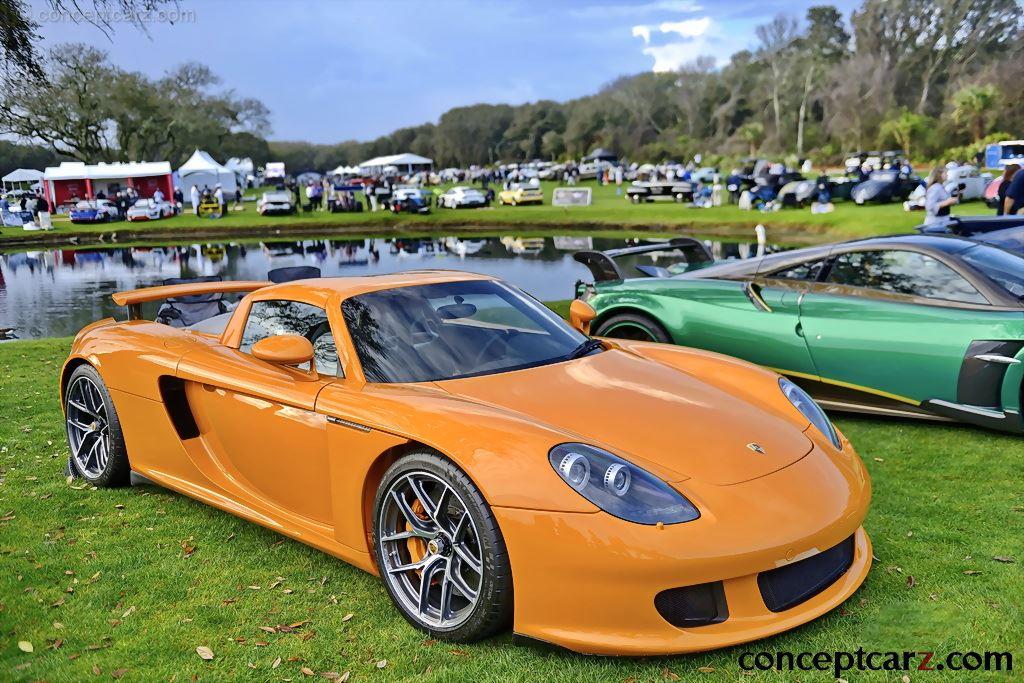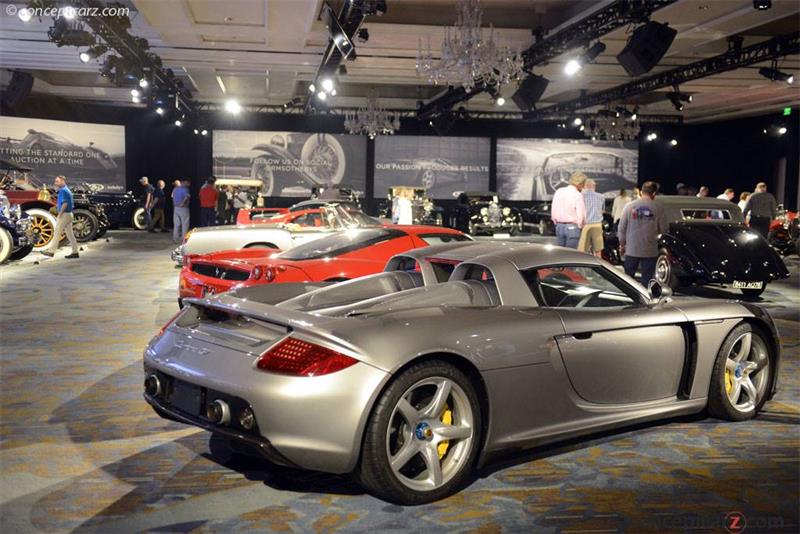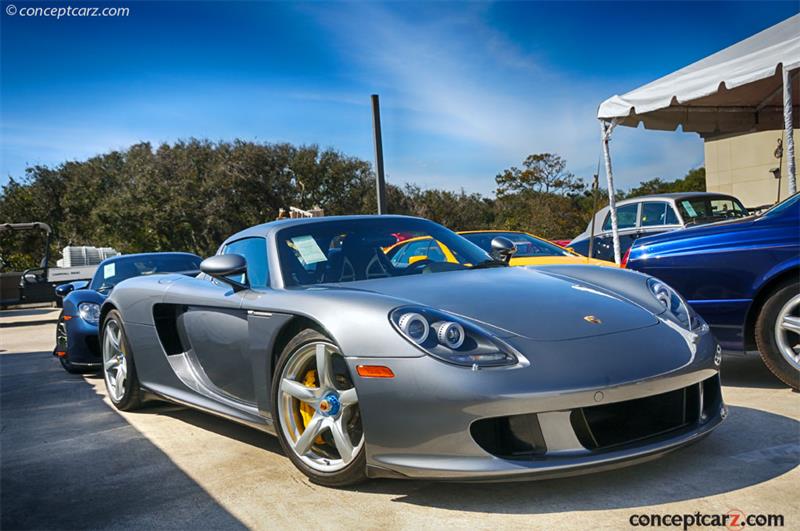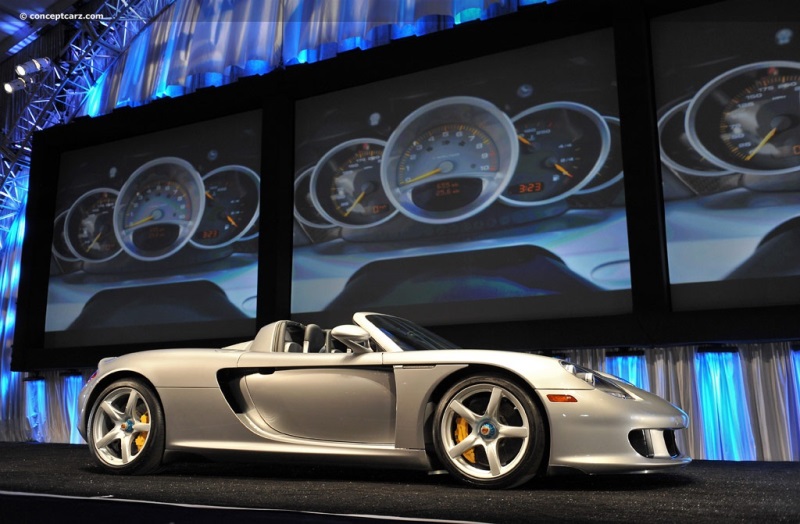Unveiled in Paris as a Concept in 2000, the German Automaker's Production Version Carries Pure Racing Genes and Showcases Future Porsche Technology
Stuttgart, Germany-based Dr. Ing. h.c. F. Porsche AG will unveil its V10-powered Carrera GT high-performance roadster in March at the Geneva International Motor Show. With more than 600 horsepower and racing-inspired technology, Porsche's top-of-the-line sports car delivers pure performance.
Coupe
Chassis #: WP0CA29864L001043
View info and history
Auction entries : 1The Carrera GT has a pure racing engine. Its 10-cylinder powerplant with dry-sump lubrication is based on Porsche's 5.5-liter V10 naturally aspirated engine developed especially for racing. For production, technicians at the Development Center in Weissach, Germany, have increased the displacement to 5.7 liters. Maximum output is 612 horsepower (DIN*) at 8,000 rpm, with peak torque rated at 437 pound-feet. The Carrera GT has a top test-track speed of 205 miles per hour (330 k/h) and accelerates from zero to 62 mph (100 km/h) in 3.9 seconds. Its specially developed six-speed manual gearbox allows it to go from zero to 124 mph (200 km/h) in 9.9 seconds. The specifications demanded a consistent lightweight construction and sports car dimensions. With a length of 15.12 feet (4.61 meters), a width of 6.3 feet (1.92 meters), a height of 3.81 feet (1.16 meters) and a wheelbase of 8.96 feet (2.73 meters), the roadster weighs 3,042 pounds (1,380 kilograms). Porsche developed a new construction concept for road and racing vehicles. The Carrera GT's monocoque and entire sub-frame are made of carbon-fiber-reinforced plastic (CFRP), and Porsche has applied to patent this technology. Carbon is the only material that, after complex processing, can meet the requirements needed to combine top-class driving performance and driving dynamics with minimum weight at maximum rigidity.
Coupe
Chassis #: WP0CA29804L001183
Engine #: 90530613
View info and history
Auction entries : 2With attainable speeds of more than 186 mph (300 km/h), aerodynamics plays a crucial role. To achieve as high output co-efficients as possible (so-called 'downforce'), the Carrera GT has an underbody geometry that can only be found in similar form in pure racing sports cars. The underbody is completely cased in carbon fiber and provides an additional suction effect thanks to its rear diffusor and flow channels.The Carrera GT also features the Porsche Ceramic Composite Brake (PCCB) system. Porsche has supplied this component since 2001 and is the first manufacturer to include it in a mass-produced vehicle (the 911 Carrera GT2). A global innovation – the PCCC (Porsche Ceramic Composite Clutch) – transmits power to the drivetrain.
The Carrera GT&s extremely light magnesium wheels are produced with a special forging process and are offered for the first time on a mass-produced vehicle. The tires were specially developed for the Carrera GT (265/35 ZR 19 in the front, and 335/30 ZR 20 in the rear). The new Porsche roadster possesses a simple-operation roof system. It consists of two individual carbon fiber lightweight shells, each weighing only 5.3 pounds (2.4 kilograms). These shells can be stored in the front luggage compartment.
Coupe
Chassis #: WP0CA29804L001037
View info and history
Auction entries : 1The first Carrera GT models produced at the Porsche plant in Leipzig, Germany, will be delivered to customers at the end of 2003.Porsche Cars North America, Inc. (PCNA), based in Atlanta, Ga., and its subsidiary, Porsche Cars Canada, Ltd., are the exclusive importers of Porsche vehicles for the United States and Canada. A wholly owned, indirect subsidiary of Dr. Ing. h.c.F. Porsche AG, PCNA employs approximately 200 people who provide Porsche vehicles, parts, marketing and training for its 203 U.S. and Canadian dealers. They, in turn, provide Porsche owners with best-in-class service.*DIN represents European horsepower ratings, SAE (North American) numbers are not yet available.Source - Porsche
Stuttgart, Germany-based Dr. Ing. h.c. F. Porsche AG will unveil its V10-powered Carrera GT high-performance roadster in March at the Geneva International Motor Show. With more than 600 horsepower and racing-inspired technology, Porsche's top-of-the-line sports car delivers pure performance.
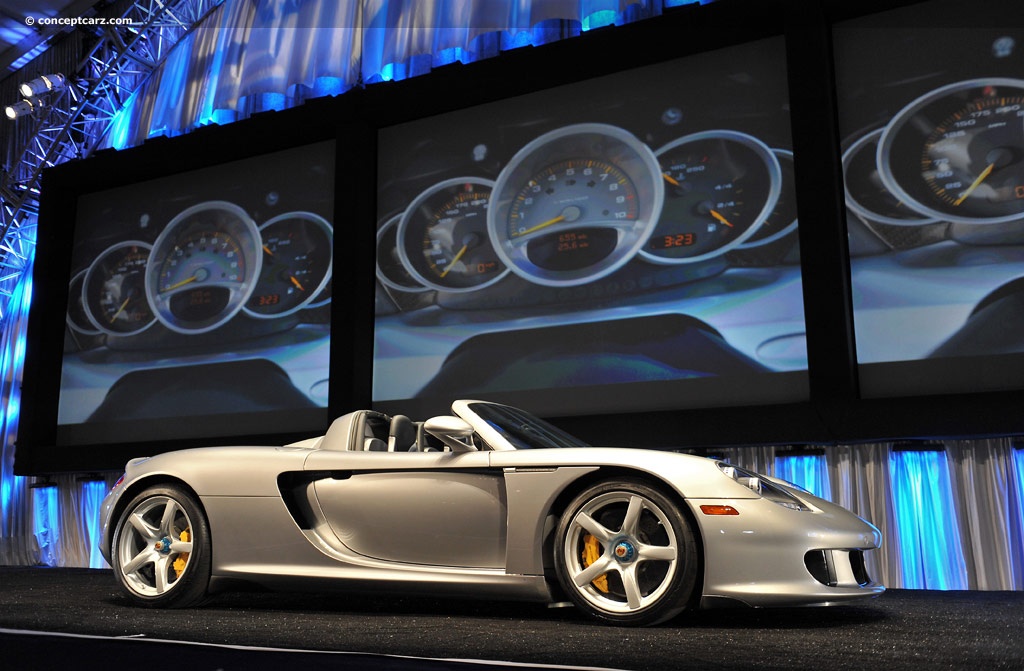
Coupe
Chassis #: WP0CA29864L001043
View info and history
Auction entries : 1
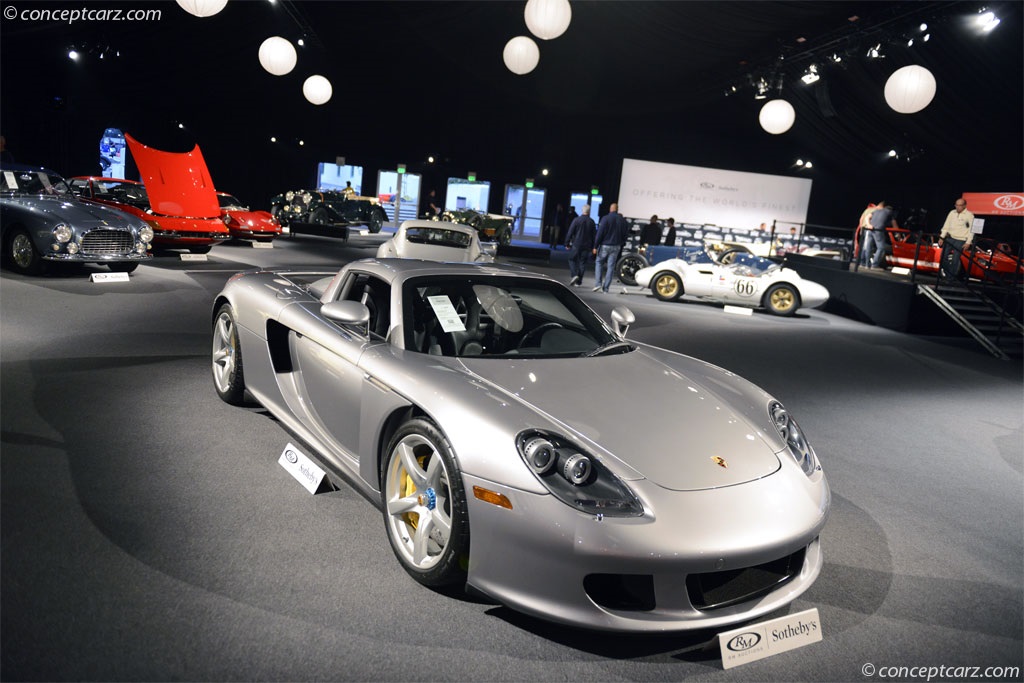
Coupe
Chassis #: WP0CA29804L001183
Engine #: 90530613
View info and history
Auction entries : 2
The Carrera GT&s extremely light magnesium wheels are produced with a special forging process and are offered for the first time on a mass-produced vehicle. The tires were specially developed for the Carrera GT (265/35 ZR 19 in the front, and 335/30 ZR 20 in the rear). The new Porsche roadster possesses a simple-operation roof system. It consists of two individual carbon fiber lightweight shells, each weighing only 5.3 pounds (2.4 kilograms). These shells can be stored in the front luggage compartment.
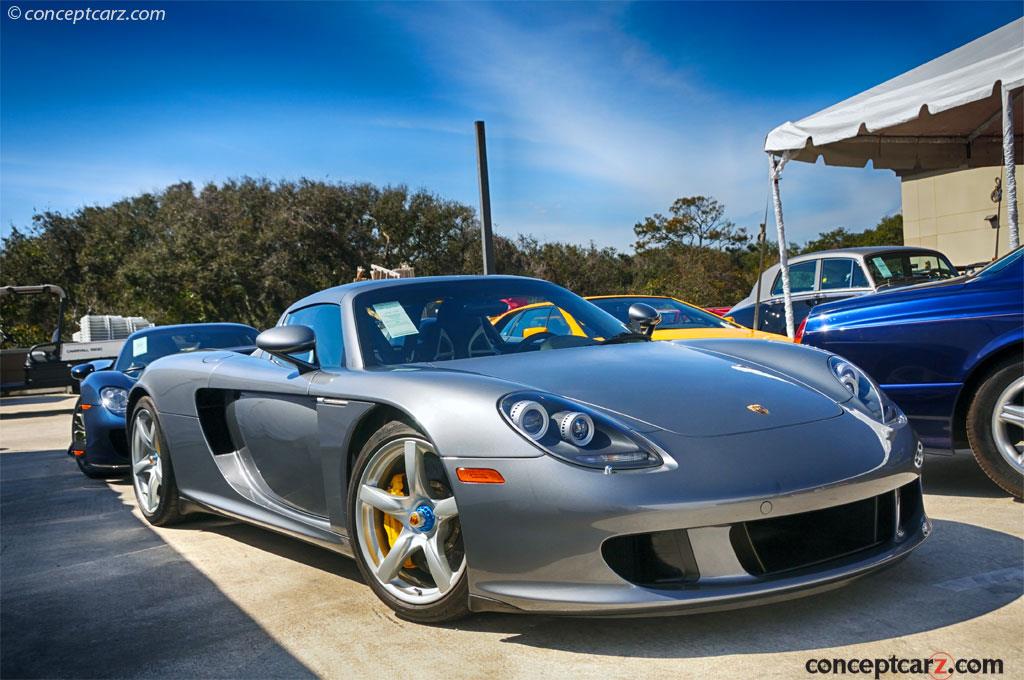
Coupe
Chassis #: WP0CA29804L001037
View info and history
Auction entries : 1
At Porsche, we have a principle that is absolutely fundamental to our philosophy of race engineering: compromise is simply not an option.
Coupe
Chassis #: WP0CA29864L001043
View info and history
Auction entries : 1By challenging convention in the search for performance, Porsche engineers have consistently arrived at innovative ideas and new automotive technologies.Along the way, we've established a long and glorious tradition of vehicles that have always exceeded expectations. A succession of cars that have endured and inspired for over 50 years.From the Nürburgring to the tracks at Daytona and Le Mans, Porsche has earned a unique place in motor racing history at virtually every track in the world. Every hairpin, corner and chicane has been studied by our drivers and engineers. Just how well is amply demonstrated by more than 23,000 racing victories in just over 50 years by Porsche factory and customer teams.
Coupe
Chassis #: WP0CA29804L001183
Engine #: 90530613
View info and history
Auction entries : 2Today, that tradition has inspired our engineers to create the next generation of Porsche. A genuine supercar based on Porsche race technology, yet ideally suited to the road.Source - Porsche

Coupe
Chassis #: WP0CA29864L001043
View info and history
Auction entries : 1

Coupe
Chassis #: WP0CA29804L001183
Engine #: 90530613
View info and history
Auction entries : 2
ATLANTA – Equipped with a V10 engine that produces more than 600 horsepower and with the most advanced, cutting-edge automotive technologies, the 2004 Porsche Carrera GT uses the undiluted qualities of a genuine racecar to provide an unprecedented driving experience on the road.
Coupe
Chassis #: WP0CA29864L001043
View info and history
Auction entries : 1The Porsche Carrera GT is a low, sleek, lightweight roadster that is as beautiful to the engineer as it is to the eye. Among the car's unique features are its 5.7-liter, 605-horsepower (SAE) V10 engine; its monocoque chassis with engine and
transmission mounts made of carbon-reinforced plastic (Porsche has registered
for a patent on this design principle which uses aerospace materials); and the first use of a ceramic composite clutch in a production car. Its aerodynamic and race-bred suspension package provides safe and stable travel at speeds of up to 205 mph (330 km/h), and the Carrera GT features a lot of lightweight materials, such as magnesium for the car's huge wheels and special sport seats. The result of such artistic and athletic equipment is a car that accelerates from a standing start to 62 mph (100 km/h) in only 3.9 seconds, reaches 100 mph (160 km/h) in less than seven seconds, 125 mph (200 km/h) in less than 10 seconds, and can achieve a top test-track speed of 205 mph (330 km/h).The Porsche Carrera GT made its stunning yet fitting debut as a prototype car at the famed Louvre art museum in Paris in the fall of 2000. After undergoing development and testing, the final production version was unveiled at the 2003
Geneva show. The Porsche Carrera GT will be built at Porsche's new plant in Leipzig, Germany, with deliveries beginning late in the 2003 calendar year.The Porsche Carrera GT design clearly indicates its athletic abilities. Yet contrary to prototypes used only in motorsports, the Carrera GT's design and character shows clear links to Porsche's production cars.
Coupe
Chassis #: WP0CA29804L001183
Engine #: 90530613
View info and history
Auction entries : 2From the front, the Carrera GT bears the typical Porsche face, with an extreme,
swept-back 'arrow' design of the front lid with wings rising up at the sides much
like the 718 RSK Spyder of the 1960s. As on the awesome Porsche 917 racecars,
flat glass covers a pair of large projection headlights that feature the most advanced and sophisticated headlight technology available with V-shaped Xenon headlamp units. Just as on the Porsche 911 Turbo, three extra-wide air intakes in the lower front fascia underscore the Carrera GT's clear commitment to outstanding
performance by providing air to cool a trio of front-mounted radiators, as well as
the ceramic front brakes.The Carrera GT's look is even more dramatic in side view, where its taut, stretched
and sleek shoulder line comes clearly into view. The mid-engine architecture is
accented by a cockpit oriented clearly toward the front of the car with a long
panel between the door and rear axle. New exterior mirrors have V-shaped
bases and match the rake of the car's A pillar.Large air intakes and side outlets in front of and behind the doors add to the car's dramatic and dynamic appearance. But, as is typical with Porsche, with form comes function; these openings are designed to ensure airflow to and from the engine, transmission, brakes and air conditioning systems. Literally 'cut into' the basic design of the car, just as on an aircraft, the air intakes are part of a highly functional aerodynamic airflow surface that enhances both the Carrera GT's athletic abilities and its aesthetic appeal.
Coupe
Chassis #: WP0CA29804L001037
View info and history
Auction entries : 1To provide a view of the engine and to enhance cooling, cross-drilled stainless
steel power domes stretch back from the rear panel behind the Carrera GT's seats.
Two supplemental safety bars just behind and above the seats enhance safety
and security as well as reinforcing the car's dramatic design. However, these
bars also have another functional role: they anchor the removable roof when it is
in place over the cockpit.At the rear of the car, a wing that spans between the tops of the fenders provides
the downforce needed for high-speed stability. To assure stability at higher speeds, the wing rises 6.3 inches (160 mm) when the car achieves 75 mph (120 km/h),
thus increasing downforce by some 30 percent. The wing retracts to its normal
position when the car slows to less than 50 mph (80 km/h).A racing-style diffuser beneath the rear section of the car enhances the aerodynamic effect of the wing and also provides a visual counterbalance to the wing's upward arc. Two stout tailpipes are integrated into the carbon fiber panel on either side of the rear license plate mount. The ribbed cover around the tailpipes is designed to enhance cooling and again reflects Porsche's clear belief in form following function.
Coupe
Chassis #: WP0CA29884L001061
Serial #: 0133
View info and history
Auction entries : 1Although hidden from view, the underside of the car was designed just as carefully
as the Carrera GT's beautiful and sleek body. A fully covered underfloor provides
ground effects to meet the demands of high-speed aerodynamics. The under floor
structure includes airflow ducts, and the rear diffuser is made of composite carbon
fiber and is firmly bolted to the chassis, engine mounts and crash structure.
Carefully designed with computerized and wind tunnel evaluation, this under floor
system channels air to maintain the car's 30/70 front/rear downforce balance.
Porsche's motor racing division designed and developed the Carrera GT's body
structure. The monocoque combines all structural functions. Unlike a conventional
body shell made from numerous separate components, the monocoque is made
from only a few elements that are bonded together in a high-pressure furnace to
form a single or mono-structure that is exceptionally rigid and strong.
Carbon fiber reinforced plastic (CFP) is the generic term for composite fiber materials that were developed primarily for aerospace applications but have been widely applied to motorsports vehicle construction. These materials provide supreme performance through their combination of minimum weight and maximum strength and stiffness. On the Carrera GT, CFP is used for the chassis, which includes the windshield frame (which is reinforced by a steel core) and supplemental safety bar system, engine/transmission support frame, doors, hoods, fenders, underfloor tray and even in many interior components.CFP is constructed from bonded layers of materials, including carbon fiber tissue,
resin and aluminum or plastic honeycomb material that can be nearly an inch in
thickness. Aluminum inserts are laminated at specific points so other components
can be attached to the load-bearing monocoque structure. The structure is sealed
in an airtight foil cover and placed in a high-pressure autoclave furnace, where
the resins form a polymer and bond the honeycomb to the carbon fiber. Such
carbon bonding creates a strong, stiff and precise structure that is also resistant
to temperature extremes.The racing-style monocoque structure provides superior torsional and flexural
stiffness, providing a strong anchor for the car's body and suspension as well as
an energy-absorbing and occupant-protecting shell. Because carbon components
are as much as 40 percent lighter, the full Carrera GT chassis weighs just more
than 220 pounds (100 kg).The Carrera GT is the first road car built around such a chassis and also the first
with an engine and transmission support made entirely of CFP, a concept
developed by Porsche's motorsports department and registered for patent. The
system was devised because of carbon-reinforced plastic's structural strength and
thermal resistance. CFP is also used in the Carrera GT's removable roof, which consists of two lightweight panels. It is held in place by rapid-action catches and can be stored in the car's front luggage compartment.The Carrera GT has steel reinforcement in its windshield structure and the
longitudinal arms commonly referred to as chassis legs are made from high-strength
stainless steel and help create a crash structure at the front and rear of the vehicle.Aluminum inserts connect the longitudinal arms to the chassis at the front and to
the engine/transmission support frame at the rear. The bumper system is made
of a strong aluminum crossbar and impact tubes.
Coupe
Chassis #: WP0CA29864L001043
View info and history
Auction entries : 1Porsche's development engineers have placed the car's fuel tank in an aluminum
drawer within the monocoque and between the passenger cell and engine compartment.
In addition to protecting the fuel tank, the chassis is designed to protect its human occupants. The Carrera GT is equipped with three-point safety belts with
pretensioners and load limitors, but the seats also are prepared to accept six-point racing belts. Passive safety equipment includes front and side airbags for both the driver and passenger. Strong steel tubes built into the Carrera GT's doors
provide additional side-impact protection.A purebred racing engine powers the Carrera GT. Porsche's development center
at Weissach, Germany, built a 5.5-liter, normally aspirated V10 engine for racing,
and that engine's bores have been enlarged to displace 5.7 liters in the Carrera GT. Maximum output is rated at 605 horsepower (SAE) at 8,000 rpm, with peak
torque of 435 lb.-ft.The engine has a very low center of gravity, a 68-degree V angle and four
valves-per-cylinder heads. The engine block serves as a load-bearing part of the
chassis structure, yet is so strong that there is no distortion to the cylinder bores.
Coupe
Chassis #: WP0CA29814L001046
Auction entries : 1Using dry-sump lubrication reduces the number of engine components and seals
and also helps optimize weight and reliability.To keep the engine as short as possible, Porsche engineers decided against
using cylinder liners. Instead, the cylinders are coated with Nikasil, a nickel and
silicon combination coating that improves wear resistance and minimizes internal
friction. The engine has a closed-deck configuration, a principle carried over from
motorsports. This closed-desk architecture enables the cylinders to be cooled by
internal water chambers that directly surround the cylinders. Three front-mounted
radiators and cross flow cooling ensure optimum heat transfer even under high
engine loads.The engine weighs only 472 pounds (214 kg.). The block, crankshaft and camshafts
are all made of light alloys. The crankshaft is designed to operate at speeds of
up to 8,400 rpm and is both forged and designed for minimum mass inertia and
thus offers maximum torsional stiffness. Pistons are connected to the crankshaft by
titanium connecting rods that are very lightweight. The crankcase is a one-piece
unit that integrates the secondary air ducts as well as the separate bearing blocks
for the camshaft. Camshaft drive is a combined sprocket/chain system with rigid
cup tappets that guarantees a stiff and sturdy valve drive with low masses and
compact dimensions. Porsche-patented VarioCam camshaft control provides the
intake camshafts with infinite adjustment within a range of 40 degrees.
The Carrera GT has a two-chamber exhaust system with one pre-catalyst and a
main catalyst on each side. The car already meets European EU4 emission
standards that do not go into effect until 2005. The exhaust system is made of
stainless steel and is precisely tuned to provide a powerful sound that includes
the high-frequency roar of a thoroughbred racing engine.
Coupe
Chassis #: WP0CA29814L001046
Auction entries : 1The engine's power reaches the rear wheels through a specially developed six-speed
manual gearbox that has compact dimensions and a low center of gravity. The
transversely mounted gearbox ensures optimum weight distribution without impairing
the position of the rear diffuser.Rather than carrying the weight of a two-mass flywheel, the transmission uses a
special shaft design: the first main shaft is a hollow tube housing the long and
thin solid shaft. This effectively creates a torsional spring that enables the shafts to dampen drive impacts and to reduce transmission noise.The Carrera GT is the first Porsche to feature the Porsche Ceramic Composite
Clutch (PCCC®), which is extremely compact and contributes to the car's low center
of gravity. The PCCC's low mass also has a positive effect on engine dynamics.
Ceramic composite clutches used in racing often have short lives, but Porsche has
created a new clutch design and configuration with a two-plate dry clutch with
ceramics made of carbon fiber and silicon carbide that are strong, light and have
an exceptional service life. The plates are only 6.65 inches (169 mm) in diameter,
less than half the size of typical production car clutch plates.
Coupe
Chassis #: WP0CA29814L001046
Auction entries : 1The Porsche Carrera GT chassis and suspension is based on the architecture of
the Porsche GT1, the car that won the 24 Hours of Le Mans race in 1998. For
example, as on the GT1, the rear track control arms of the Carrera GT are made
of aerodynamically designed steel tubes. However, Porsche engineers did not forget
the need for driving comfort on the street when they adapted such racing-bred
systems for the new supercar.Like a racecar, the Carrera GT uses pushrod suspension with double-track control
arms at all four corners to give the Carrera GT its refined response and behavior,
feeding forces smoothly and efficiently into the car's chassis. Where many cars
use MacPherson spring struts, the Carrera GT's spring and damper elements are
operated by stainless steel pushrods and pivot levers, which separate the guidance
function from the spring action. Advantages include more sensitive response and
behavior as well as precise suspension tuning for both high and low speeds.
Forged aluminum control arms resting on broad mounts feed wheel forces into the
chassis. As on a racecar, the control arms are bolted on the chassis without rubber
insulators, providing the most precise and direct wheel guidance at all times. The
Carrera GT's superior driving dynamics are further enhanced by a power steering
system that has its safety steering column also bolted directly to the monocoque
body structure.
The Carrera GT is equipped with Porsche Ceramic Composite Brakes (PCCB®),
which have been optimized and enlarged. The cross-drilled composite ceramic brake
discs are 14.96 inches (380 mm) in diameter at all four corners of the car. Those
discs are 1.34 inches (34 mm) thick, yet are 50 percent lighter than comparable
cast iron discs. Porsche composite brakes provide immediate, frictionally consistent and optimized response while slowing the Carrera GT. Maximum brake power is built up within fractions of a second, yet abrasion is kept to an absolute minimum and the brakes have a substantial safety reserve even under extreme loads. Six-piston monoblock aluminum brake calipers front and rear are brand new and feature extremely large and firmly bolted connections to the wheel mounts, giving the driver good feel through the brake pedal. Short stopping distances are ensured by the hydraulic brake servo that builds pressure very quickly and efficiently.The antilock braking system and traction control serve to ensure dynamic driving
behavior even in transitional road surfaces and in inclement weather. The Carrera
GT has four-channel anti-spin control (ASC) geared specifically for its ceramic brakes to provide short stopping distances with precise steering control. ASC is activated when required throughout the car's entire range of acceleration, preventing excessive wheel spin on the drive wheels and thus avoiding any instability at the rear of the car.
Coupe
Chassis #: WP0CA29804L001037
View info and history
Auction entries : 1ASC can intervene in engine management to reduce power to the degree required.
While they are spinning, the drive wheels are slowed by automatic brake differential (ABD) technology. However, the driver can switch off the traction control function
by pressing a button on the center console.The Carrera GT rides on large, five-spoke wheels, which are the first production car application of forged magnesium rims made from a special manufacturing process
that enhances strength while reducing weight. The forged magnesium wheels are
some 25 percent lighter than cast aluminum wheels and thus reduce unsprung weight
to a new level. The result is supreme traction as well as smooth and sure spring
and damper action.The wheels are 19 inches in diameter and 9.5 inches wide for the front of the car
and 20 inches in diameter and 12.5 inches wide at the rear. The wheels feature
motorsports-style central wheel locks on their hubs.Special tires were developed for the Carrera GT. They measure 265/35 X 19 in
front and 335/30 X 20 in the rear. The tires are Z rated and have outstanding
grip and consistent behavior at high speeds, yet have a relatively low level of wear for such high-performance tires.Despite its racing-oriented performance, the Porsche Carrera GT does not have a
spartan interior. The cockpit is characterized by function-oriented ambience with
extensive use of high-tech materials. Carbon, magnesium and leather dominate
interior materials, with composite components either in their natural state or painted to match the magnesium pieces.The car's center console is made of composite materials covered in galvanized
magnesium. The shift lever is positioned about halfway up the console and is directly next to the steering wheel. The shift lever has a ball-shaped knob made of
lightweight stratified birch/ash wood meant to remind drivers of the balsa wood
shift knob in the 1970 Le Mans-winning Porsche 917.The Carrera GT features a new seat design and structure. The seats are finished
in smooth leather and have manual adjustment because power motors would add
unnecessary weight. The seats are made of a composite carbon shell. Each seat
weighs only 23.6 pounds (10.7 kg.), compared to 28.9 pounds (13.1 kg.) for the
seats in the Porsche GT3 or 44.1 pounds (20 kg.) for the seats in a Porsche
911 Carrera.Air conditioning is optimized for weight and the car comes with a standard air
filter system. Even though the Carrera GT is a serious performance car, it can
be equipped with many comfort features, including a navigation system and
Bose® audio.The Carrera GT also comes with its own five-piece set of leather luggage matched
to the car's interior color – Terracotta, Dark Grey Nature, Ascot Brown/Black
Nature. Each piece of luggage is designed for a precise place within the car: the
clothes bag fits behind the passenger's seat, the attaché case fits in the
passenger's foot well, the shoulder bag fits between the passenger's seat and door,
a center console bag fits beneath the console and there are leather bags in special
storage boxes within the doors and a travel bag in the luggage compartment.
The luggage compartment is lined with a checkered fabric and can hold 2.68 cu.-ft.
(76 liters) of cargo. Special leather straps hold the two roof panels in position
when they are in the compartment.Every new Porsche car sold in the United States and Canada is covered by a
four-year/50,000-mile (80,000 kilometer), bumper-to-bumper limited warranty,
which includes Porsche's roadside assistance program. The galvanized body and
26-step paint and anti-corrosion process enable Porsche to warranty each car
against rust perforation for 10 years and unlimited mileage. In addition, Porsche
guarantees the paint will be free of defects in material or workmanship for four
years or 50,000 miles.Porsche Cars North America, Inc. (PCNA), based in Atlanta, Ga., and its
subsidiary, Porsche Cars Canada, Ltd., are the exclusive importers of Porsche
vehicles for the United States and Canada. A wholly owned, indirect subsidiary of
Dr. Ing. h.c.F. Porsche AG, PCNA employs approximately 250 people who provide
Porsche vehicles, parts, service, marketing and training for its 204 U.S. and
Canadian dealers. They, in turn, provide Porsche owners with best-in-class service.Source - Porsche

Coupe
Chassis #: WP0CA29864L001043
View info and history
Auction entries : 1
transmission mounts made of carbon-reinforced plastic (Porsche has registered
for a patent on this design principle which uses aerospace materials); and the first use of a ceramic composite clutch in a production car. Its aerodynamic and race-bred suspension package provides safe and stable travel at speeds of up to 205 mph (330 km/h), and the Carrera GT features a lot of lightweight materials, such as magnesium for the car's huge wheels and special sport seats. The result of such artistic and athletic equipment is a car that accelerates from a standing start to 62 mph (100 km/h) in only 3.9 seconds, reaches 100 mph (160 km/h) in less than seven seconds, 125 mph (200 km/h) in less than 10 seconds, and can achieve a top test-track speed of 205 mph (330 km/h).The Porsche Carrera GT made its stunning yet fitting debut as a prototype car at the famed Louvre art museum in Paris in the fall of 2000. After undergoing development and testing, the final production version was unveiled at the 2003
Geneva show. The Porsche Carrera GT will be built at Porsche's new plant in Leipzig, Germany, with deliveries beginning late in the 2003 calendar year.The Porsche Carrera GT design clearly indicates its athletic abilities. Yet contrary to prototypes used only in motorsports, the Carrera GT's design and character shows clear links to Porsche's production cars.

Coupe
Chassis #: WP0CA29804L001183
Engine #: 90530613
View info and history
Auction entries : 2
swept-back 'arrow' design of the front lid with wings rising up at the sides much
like the 718 RSK Spyder of the 1960s. As on the awesome Porsche 917 racecars,
flat glass covers a pair of large projection headlights that feature the most advanced and sophisticated headlight technology available with V-shaped Xenon headlamp units. Just as on the Porsche 911 Turbo, three extra-wide air intakes in the lower front fascia underscore the Carrera GT's clear commitment to outstanding
performance by providing air to cool a trio of front-mounted radiators, as well as
the ceramic front brakes.The Carrera GT's look is even more dramatic in side view, where its taut, stretched
and sleek shoulder line comes clearly into view. The mid-engine architecture is
accented by a cockpit oriented clearly toward the front of the car with a long
panel between the door and rear axle. New exterior mirrors have V-shaped
bases and match the rake of the car's A pillar.Large air intakes and side outlets in front of and behind the doors add to the car's dramatic and dynamic appearance. But, as is typical with Porsche, with form comes function; these openings are designed to ensure airflow to and from the engine, transmission, brakes and air conditioning systems. Literally 'cut into' the basic design of the car, just as on an aircraft, the air intakes are part of a highly functional aerodynamic airflow surface that enhances both the Carrera GT's athletic abilities and its aesthetic appeal.

Coupe
Chassis #: WP0CA29804L001037
View info and history
Auction entries : 1
steel power domes stretch back from the rear panel behind the Carrera GT's seats.
Two supplemental safety bars just behind and above the seats enhance safety
and security as well as reinforcing the car's dramatic design. However, these
bars also have another functional role: they anchor the removable roof when it is
in place over the cockpit.At the rear of the car, a wing that spans between the tops of the fenders provides
the downforce needed for high-speed stability. To assure stability at higher speeds, the wing rises 6.3 inches (160 mm) when the car achieves 75 mph (120 km/h),
thus increasing downforce by some 30 percent. The wing retracts to its normal
position when the car slows to less than 50 mph (80 km/h).A racing-style diffuser beneath the rear section of the car enhances the aerodynamic effect of the wing and also provides a visual counterbalance to the wing's upward arc. Two stout tailpipes are integrated into the carbon fiber panel on either side of the rear license plate mount. The ribbed cover around the tailpipes is designed to enhance cooling and again reflects Porsche's clear belief in form following function.
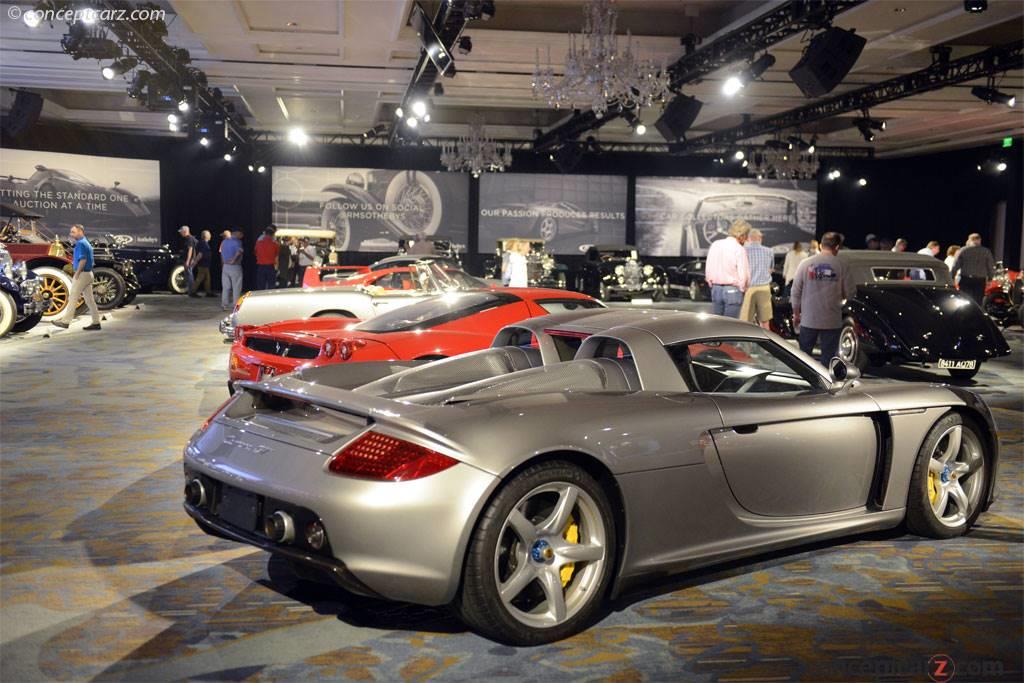
Coupe
Chassis #: WP0CA29884L001061
Serial #: 0133
View info and history
Auction entries : 1
as the Carrera GT's beautiful and sleek body. A fully covered underfloor provides
ground effects to meet the demands of high-speed aerodynamics. The under floor
structure includes airflow ducts, and the rear diffuser is made of composite carbon
fiber and is firmly bolted to the chassis, engine mounts and crash structure.
Carefully designed with computerized and wind tunnel evaluation, this under floor
system channels air to maintain the car's 30/70 front/rear downforce balance.
Porsche's motor racing division designed and developed the Carrera GT's body
structure. The monocoque combines all structural functions. Unlike a conventional
body shell made from numerous separate components, the monocoque is made
from only a few elements that are bonded together in a high-pressure furnace to
form a single or mono-structure that is exceptionally rigid and strong.
Carbon fiber reinforced plastic (CFP) is the generic term for composite fiber materials that were developed primarily for aerospace applications but have been widely applied to motorsports vehicle construction. These materials provide supreme performance through their combination of minimum weight and maximum strength and stiffness. On the Carrera GT, CFP is used for the chassis, which includes the windshield frame (which is reinforced by a steel core) and supplemental safety bar system, engine/transmission support frame, doors, hoods, fenders, underfloor tray and even in many interior components.CFP is constructed from bonded layers of materials, including carbon fiber tissue,
resin and aluminum or plastic honeycomb material that can be nearly an inch in
thickness. Aluminum inserts are laminated at specific points so other components
can be attached to the load-bearing monocoque structure. The structure is sealed
in an airtight foil cover and placed in a high-pressure autoclave furnace, where
the resins form a polymer and bond the honeycomb to the carbon fiber. Such
carbon bonding creates a strong, stiff and precise structure that is also resistant
to temperature extremes.The racing-style monocoque structure provides superior torsional and flexural
stiffness, providing a strong anchor for the car's body and suspension as well as
an energy-absorbing and occupant-protecting shell. Because carbon components
are as much as 40 percent lighter, the full Carrera GT chassis weighs just more
than 220 pounds (100 kg).The Carrera GT is the first road car built around such a chassis and also the first
with an engine and transmission support made entirely of CFP, a concept
developed by Porsche's motorsports department and registered for patent. The
system was devised because of carbon-reinforced plastic's structural strength and
thermal resistance. CFP is also used in the Carrera GT's removable roof, which consists of two lightweight panels. It is held in place by rapid-action catches and can be stored in the car's front luggage compartment.The Carrera GT has steel reinforcement in its windshield structure and the
longitudinal arms commonly referred to as chassis legs are made from high-strength
stainless steel and help create a crash structure at the front and rear of the vehicle.Aluminum inserts connect the longitudinal arms to the chassis at the front and to
the engine/transmission support frame at the rear. The bumper system is made
of a strong aluminum crossbar and impact tubes.
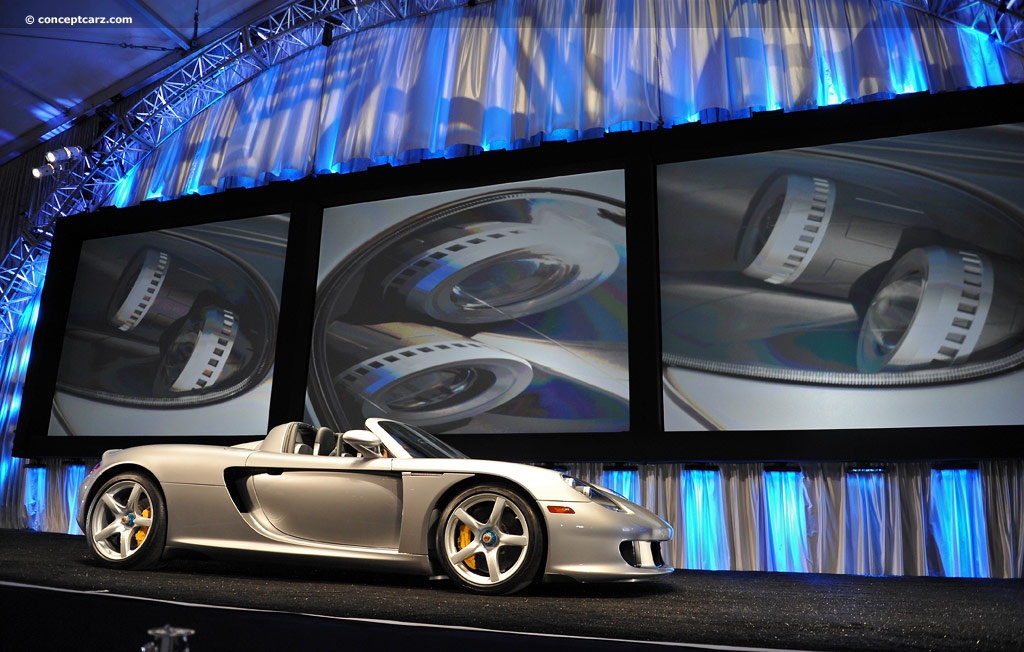
Coupe
Chassis #: WP0CA29864L001043
View info and history
Auction entries : 1
drawer within the monocoque and between the passenger cell and engine compartment.
In addition to protecting the fuel tank, the chassis is designed to protect its human occupants. The Carrera GT is equipped with three-point safety belts with
pretensioners and load limitors, but the seats also are prepared to accept six-point racing belts. Passive safety equipment includes front and side airbags for both the driver and passenger. Strong steel tubes built into the Carrera GT's doors
provide additional side-impact protection.A purebred racing engine powers the Carrera GT. Porsche's development center
at Weissach, Germany, built a 5.5-liter, normally aspirated V10 engine for racing,
and that engine's bores have been enlarged to displace 5.7 liters in the Carrera GT. Maximum output is rated at 605 horsepower (SAE) at 8,000 rpm, with peak
torque of 435 lb.-ft.The engine has a very low center of gravity, a 68-degree V angle and four
valves-per-cylinder heads. The engine block serves as a load-bearing part of the
chassis structure, yet is so strong that there is no distortion to the cylinder bores.
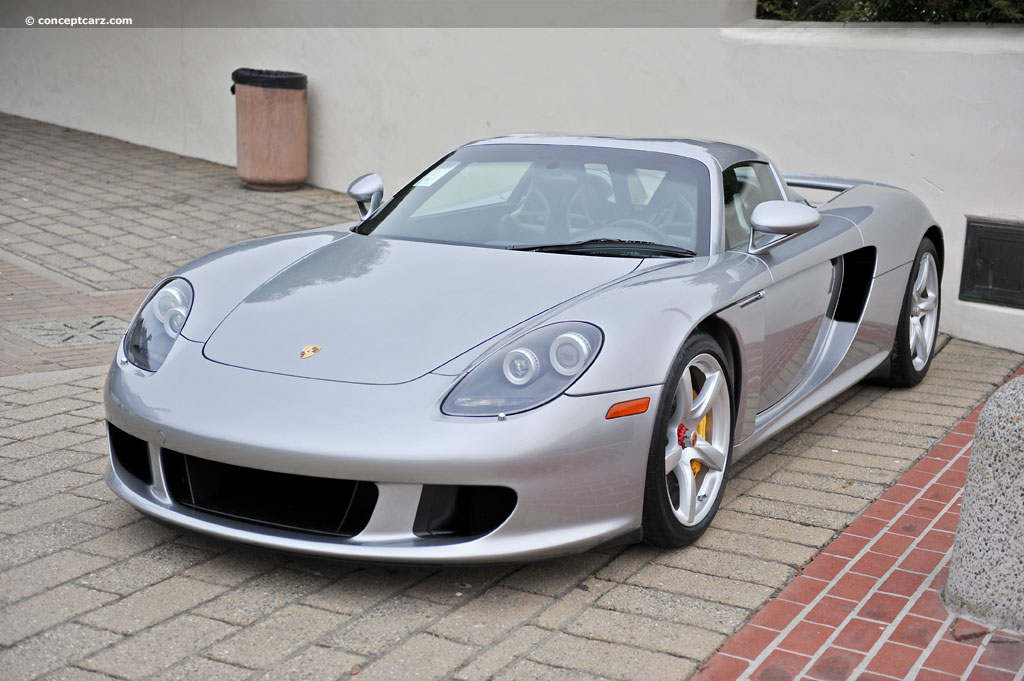
Coupe
Chassis #: WP0CA29814L001046
Auction entries : 1
and also helps optimize weight and reliability.To keep the engine as short as possible, Porsche engineers decided against
using cylinder liners. Instead, the cylinders are coated with Nikasil, a nickel and
silicon combination coating that improves wear resistance and minimizes internal
friction. The engine has a closed-deck configuration, a principle carried over from
motorsports. This closed-desk architecture enables the cylinders to be cooled by
internal water chambers that directly surround the cylinders. Three front-mounted
radiators and cross flow cooling ensure optimum heat transfer even under high
engine loads.The engine weighs only 472 pounds (214 kg.). The block, crankshaft and camshafts
are all made of light alloys. The crankshaft is designed to operate at speeds of
up to 8,400 rpm and is both forged and designed for minimum mass inertia and
thus offers maximum torsional stiffness. Pistons are connected to the crankshaft by
titanium connecting rods that are very lightweight. The crankcase is a one-piece
unit that integrates the secondary air ducts as well as the separate bearing blocks
for the camshaft. Camshaft drive is a combined sprocket/chain system with rigid
cup tappets that guarantees a stiff and sturdy valve drive with low masses and
compact dimensions. Porsche-patented VarioCam camshaft control provides the
intake camshafts with infinite adjustment within a range of 40 degrees.
The Carrera GT has a two-chamber exhaust system with one pre-catalyst and a
main catalyst on each side. The car already meets European EU4 emission
standards that do not go into effect until 2005. The exhaust system is made of
stainless steel and is precisely tuned to provide a powerful sound that includes
the high-frequency roar of a thoroughbred racing engine.
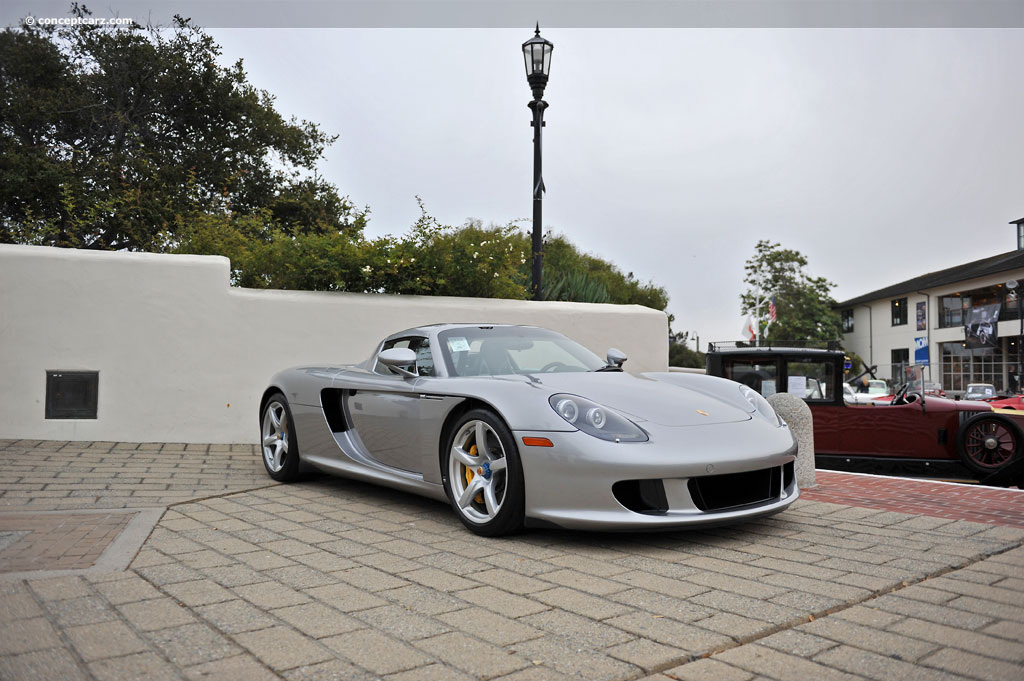
Coupe
Chassis #: WP0CA29814L001046
Auction entries : 1
manual gearbox that has compact dimensions and a low center of gravity. The
transversely mounted gearbox ensures optimum weight distribution without impairing
the position of the rear diffuser.Rather than carrying the weight of a two-mass flywheel, the transmission uses a
special shaft design: the first main shaft is a hollow tube housing the long and
thin solid shaft. This effectively creates a torsional spring that enables the shafts to dampen drive impacts and to reduce transmission noise.The Carrera GT is the first Porsche to feature the Porsche Ceramic Composite
Clutch (PCCC®), which is extremely compact and contributes to the car's low center
of gravity. The PCCC's low mass also has a positive effect on engine dynamics.
Ceramic composite clutches used in racing often have short lives, but Porsche has
created a new clutch design and configuration with a two-plate dry clutch with
ceramics made of carbon fiber and silicon carbide that are strong, light and have
an exceptional service life. The plates are only 6.65 inches (169 mm) in diameter,
less than half the size of typical production car clutch plates.
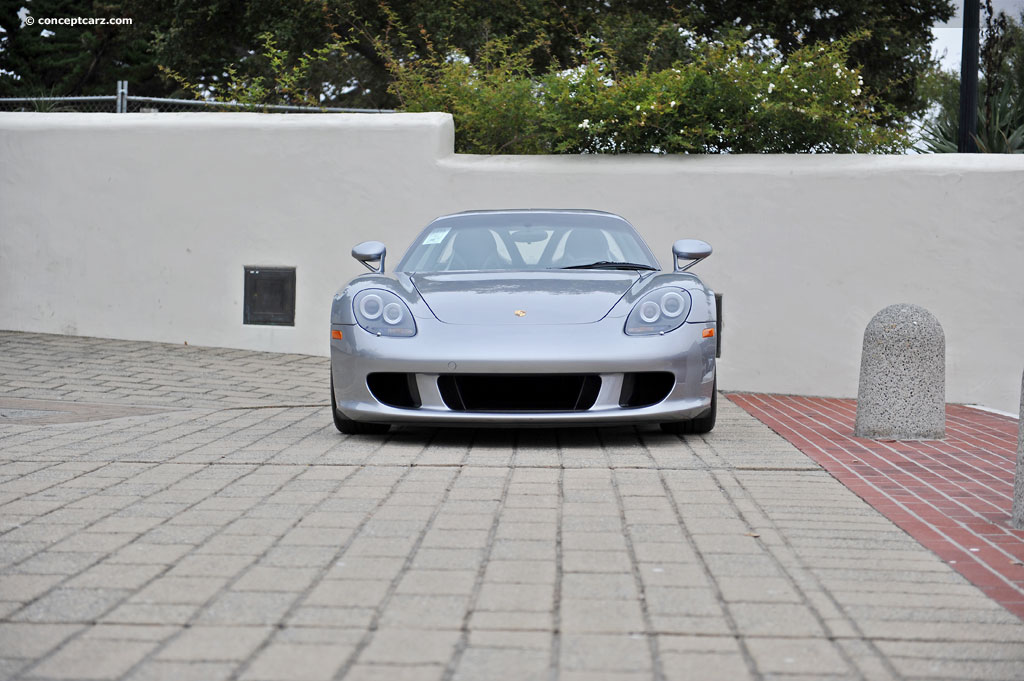
Coupe
Chassis #: WP0CA29814L001046
Auction entries : 1
the Porsche GT1, the car that won the 24 Hours of Le Mans race in 1998. For
example, as on the GT1, the rear track control arms of the Carrera GT are made
of aerodynamically designed steel tubes. However, Porsche engineers did not forget
the need for driving comfort on the street when they adapted such racing-bred
systems for the new supercar.Like a racecar, the Carrera GT uses pushrod suspension with double-track control
arms at all four corners to give the Carrera GT its refined response and behavior,
feeding forces smoothly and efficiently into the car's chassis. Where many cars
use MacPherson spring struts, the Carrera GT's spring and damper elements are
operated by stainless steel pushrods and pivot levers, which separate the guidance
function from the spring action. Advantages include more sensitive response and
behavior as well as precise suspension tuning for both high and low speeds.
Forged aluminum control arms resting on broad mounts feed wheel forces into the
chassis. As on a racecar, the control arms are bolted on the chassis without rubber
insulators, providing the most precise and direct wheel guidance at all times. The
Carrera GT's superior driving dynamics are further enhanced by a power steering
system that has its safety steering column also bolted directly to the monocoque
body structure.
The Carrera GT is equipped with Porsche Ceramic Composite Brakes (PCCB®),
which have been optimized and enlarged. The cross-drilled composite ceramic brake
discs are 14.96 inches (380 mm) in diameter at all four corners of the car. Those
discs are 1.34 inches (34 mm) thick, yet are 50 percent lighter than comparable
cast iron discs. Porsche composite brakes provide immediate, frictionally consistent and optimized response while slowing the Carrera GT. Maximum brake power is built up within fractions of a second, yet abrasion is kept to an absolute minimum and the brakes have a substantial safety reserve even under extreme loads. Six-piston monoblock aluminum brake calipers front and rear are brand new and feature extremely large and firmly bolted connections to the wheel mounts, giving the driver good feel through the brake pedal. Short stopping distances are ensured by the hydraulic brake servo that builds pressure very quickly and efficiently.The antilock braking system and traction control serve to ensure dynamic driving
behavior even in transitional road surfaces and in inclement weather. The Carrera
GT has four-channel anti-spin control (ASC) geared specifically for its ceramic brakes to provide short stopping distances with precise steering control. ASC is activated when required throughout the car's entire range of acceleration, preventing excessive wheel spin on the drive wheels and thus avoiding any instability at the rear of the car.
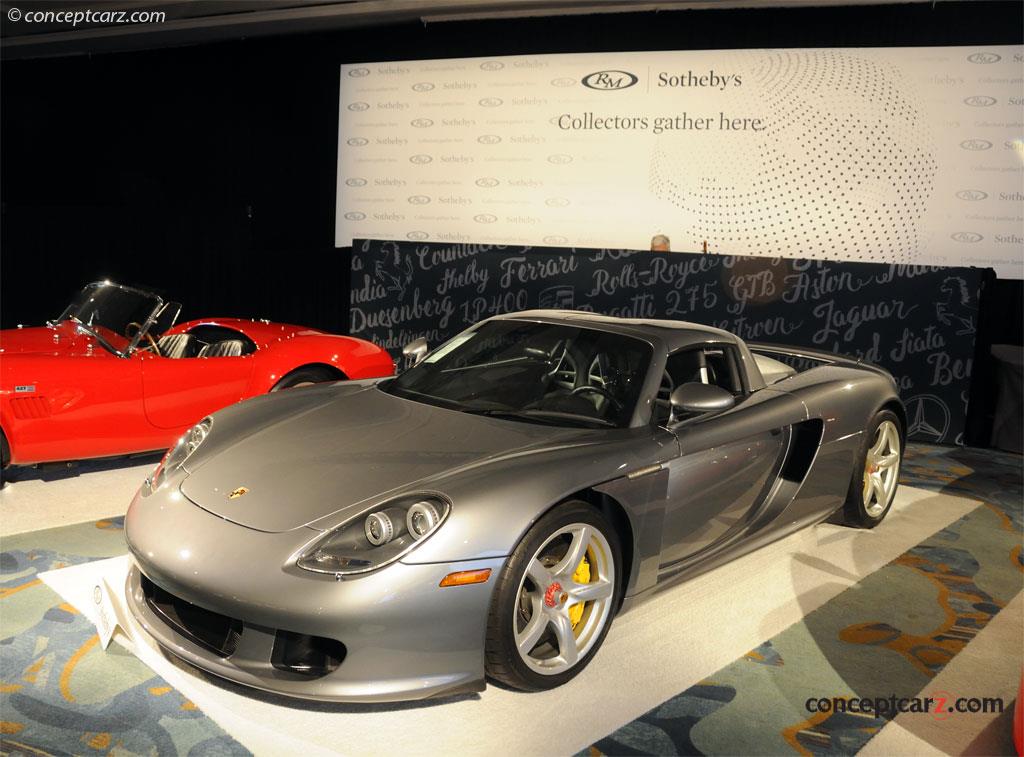
Coupe
Chassis #: WP0CA29804L001037
View info and history
Auction entries : 1
While they are spinning, the drive wheels are slowed by automatic brake differential (ABD) technology. However, the driver can switch off the traction control function
by pressing a button on the center console.The Carrera GT rides on large, five-spoke wheels, which are the first production car application of forged magnesium rims made from a special manufacturing process
that enhances strength while reducing weight. The forged magnesium wheels are
some 25 percent lighter than cast aluminum wheels and thus reduce unsprung weight
to a new level. The result is supreme traction as well as smooth and sure spring
and damper action.The wheels are 19 inches in diameter and 9.5 inches wide for the front of the car
and 20 inches in diameter and 12.5 inches wide at the rear. The wheels feature
motorsports-style central wheel locks on their hubs.Special tires were developed for the Carrera GT. They measure 265/35 X 19 in
front and 335/30 X 20 in the rear. The tires are Z rated and have outstanding
grip and consistent behavior at high speeds, yet have a relatively low level of wear for such high-performance tires.Despite its racing-oriented performance, the Porsche Carrera GT does not have a
spartan interior. The cockpit is characterized by function-oriented ambience with
extensive use of high-tech materials. Carbon, magnesium and leather dominate
interior materials, with composite components either in their natural state or painted to match the magnesium pieces.The car's center console is made of composite materials covered in galvanized
magnesium. The shift lever is positioned about halfway up the console and is directly next to the steering wheel. The shift lever has a ball-shaped knob made of
lightweight stratified birch/ash wood meant to remind drivers of the balsa wood
shift knob in the 1970 Le Mans-winning Porsche 917.The Carrera GT features a new seat design and structure. The seats are finished
in smooth leather and have manual adjustment because power motors would add
unnecessary weight. The seats are made of a composite carbon shell. Each seat
weighs only 23.6 pounds (10.7 kg.), compared to 28.9 pounds (13.1 kg.) for the
seats in the Porsche GT3 or 44.1 pounds (20 kg.) for the seats in a Porsche
911 Carrera.Air conditioning is optimized for weight and the car comes with a standard air
filter system. Even though the Carrera GT is a serious performance car, it can
be equipped with many comfort features, including a navigation system and
Bose® audio.The Carrera GT also comes with its own five-piece set of leather luggage matched
to the car's interior color – Terracotta, Dark Grey Nature, Ascot Brown/Black
Nature. Each piece of luggage is designed for a precise place within the car: the
clothes bag fits behind the passenger's seat, the attaché case fits in the
passenger's foot well, the shoulder bag fits between the passenger's seat and door,
a center console bag fits beneath the console and there are leather bags in special
storage boxes within the doors and a travel bag in the luggage compartment.
The luggage compartment is lined with a checkered fabric and can hold 2.68 cu.-ft.
(76 liters) of cargo. Special leather straps hold the two roof panels in position
when they are in the compartment.Every new Porsche car sold in the United States and Canada is covered by a
four-year/50,000-mile (80,000 kilometer), bumper-to-bumper limited warranty,
which includes Porsche's roadside assistance program. The galvanized body and
26-step paint and anti-corrosion process enable Porsche to warranty each car
against rust perforation for 10 years and unlimited mileage. In addition, Porsche
guarantees the paint will be free of defects in material or workmanship for four
years or 50,000 miles.Porsche Cars North America, Inc. (PCNA), based in Atlanta, Ga., and its
subsidiary, Porsche Cars Canada, Ltd., are the exclusive importers of Porsche
vehicles for the United States and Canada. A wholly owned, indirect subsidiary of
Dr. Ing. h.c.F. Porsche AG, PCNA employs approximately 250 people who provide
Porsche vehicles, parts, service, marketing and training for its 204 U.S. and
Canadian dealers. They, in turn, provide Porsche owners with best-in-class service.Source - Porsche
Related Reading : Porsche Carrera GT History
The manufacture of the most successful supercar in history has come to an end. Production of the Carrera GT at Porsches facility in Leipzig, Germany, concluded on Saturday, May 6, 2006, bringing to a close the latest series in a line of ultra-exclusive and ultra-performing automobiles from Porsche. In its brief production run, and befitting its ethereal performance, the award-winning Carrera GT....
Continue Reading >>
Continue Reading >>
Similar Automakers
2004 Porsche Carrera GT Vehicle Profiles
Recent Vehicle Additions
Performance and Specification Comparison
Price Comparison
$42,600
$55,900
$69,300
Related Automotive News

All-New 2017 Alfa Romeo Giulia Ti Wins Affordable Panoramic Category At Topless In Miami Competition
Industry accolade comes courtesy of the Southern Automotive Media Association (SAMA) with the 2017 Alfa Romeo Giulias Topless in Miami debut
Giulia is very well-equipped with standard premium features, including a best-in-class 280-hp turbocharg...

ALFA ROMEO ANNOUNCES PRICING FOR ALL-NEW 2017 GIULIA LINEUP
Premium Mid-size Sedan Named Car of the Year by Top Gear Magazine Starts at %2437,995 MSRP %26 Record-Breaking 505-hp Quadrifoglio at %2472,000 MSRP
All-new Giulia lineup combines Italian craftsmanship, class-leading performance, state-of-the-ar...

THE McLAREN F1
FOR THE DRIVER VITALLY – AS IN ONE OF McLARENS WORLD CHAMPION RACING CARS – DRIVER AND VEHICLE BECOME ENTIRELY AS ONE
The primary design consideration for the McLaren F1 has been to make it without reserve a drivers car, an extremely high-performance...

2016 LEXUS GS F PERFORMANCE SEDAN OFFERS A DYNAMIC RIDE, LUXURIOUS COMFORT FOR FIVE
Latest addition to F brand stable of performance cars
Aggressive-yet-elegant exterior styling with a well-appointed interior cabin
High-revving naturally aspirated 5.0-liter V8 produces 467 Horsepower
Standard Lexus Safety System to Help Brin...

2016 Lexus GS F Performance Sedan Offers a Dynamic Ride, Luxurious Comfort for Five
Latest addition to F brand stable of performance cars
Aggressive-yet-elegant exterior styling with a well-appointed interior cabin
High-revving naturally aspirated 5.0-liter V8 produces 467 Horsepower
Standard Lexus Safety System to Help Brin...
